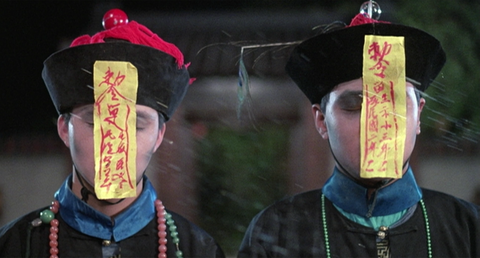When we talk about zombies, we often think of scenes from Dawn of the Dead, with a group of survivors escaping from a chaotic zombie apocalypse in a local mall. With vampires, we think of Edward or Bella wearing a cloak and feeding on blood at night in Twilight. However, there is another type of creature known as the Chinese zombie or Jiangshi (僵尸), which holds a combination of characteristics of both creatures.
Jiangshi, Chinese for “Stiff Corpse”, is said to be the result of the soul departing the corpse while the corporal energy still remains within, allowing the corpse to move around without consciousness. According to folklores that were first referenced during the Qing Dynasty, there are numerous reasons behind their odd corporal reanimation, including spirit possession, improper burial, dying with spiritual imbalances, or even being infected by a “jiangshi virus.” The growing influence of Western horror movies, however, introduced bloodsucking to Jiangshi’s repertoire which in turn resulted in movies with titles that refer to jiangshi as “Chinese vampires”.
If you like horror movies, we made a list of 5 Toe-Curling Chinese Horror Moves to Watch.
 Typical jiangshi: arms outstretched in hopping motion
Typical jiangshi: arms outstretched in hopping motion
The current portrayal of Chinese zombies/vampires is mostly visualized under the influence of Hong Kong jiangshi movies. The choice of the Qing Dynasty official garment for jiangshi is a result of low-budget filmmaking in the mid 20th century. There was a surplus of Qing Dynasty costumes in the Hong Kong film and TV industry at the time which was why the costumes were chosen.
 Officious uniform of a Qing Dynasty bureaucrat
Officious uniform of a Qing Dynasty bureaucrat
 Poster of Mr.Vampire 2
Poster of Mr.Vampire 2
The encapsulating genre of Hong Kong jiangshi movies reached its peak in the mid-1980s with the release of the horror-comedy series Mr.Vampire (僵尸先生). The series essentially presents stories of Hong Kong inhabitants fighting zombies using ancient weapons and techniques.
Taoist priest (道士) is a character that usually comes alongside jiangshi. This character is essentially inspired by the corpse handlers from Xiang Xi (湘西赶尸人). The corpse handlers were said to be skilled in carrying the dead through the difficult mountain routes and back to their homes where they could be laid to rest. This haunting job and the daunting landscape spiked the imagination of storytellers.
Therefore, rather than exorcise jiangshi, the Taoist priests in the films are guiding and navigating the lost souls and spirits of the Chinese zombies to prevent them from wandering.
Shop Chinese jiangshi zombie & priest lego moc figures.
 Lam Ching-ying as the Taoist Priest in Mr.Vampire
Lam Ching-ying as the Taoist Priest in Mr.Vampire
 Lv Chunyang, a famous Taoist of the Middle Tang Dynasty, loved to travel with a sword
Lv Chunyang, a famous Taoist of the Middle Tang Dynasty, loved to travel with a sword
Most of the jiangshi films feature Taoist priests who are mortal yet well-versed in the ways of the world, with Lam Ching-ying (林正英) playing the most iconic of them all. His earthy pressure stunts and his elaborate "Maoshan Taoist techniques", coupled with his image of being a serious but occasionally cold-hearted comedian, have made him the ultimate Taoist priest symbol.
The first and most well-known tool for a Taoist priest is the talisman. The use of talisman is essentially to make the corpses move by themselves for easier transportation. Talismans are written in vermillion which represents pure Yang energy. By tacking a talisman to the forehead of the corpse would enable the jiangshi to be controlled by the priest in doing whatever he orders.

 Scenes from Mr. Vampire
Scenes from Mr. Vampire
Another tool that comes hand in hand with the talisman is the Bagua mirror (八卦镜). Bagua mirror has eight trigrams around it, symbolizing the power of Yin & Yang. Therefore, it has the effect of killing zombies, and is similar to a blue-flame Gatling, hitting a large area at once. However, this method can only deal with low-level zombies, and when it comes to big demons, more powerful demon-subduing treasures are needed.
 Taoist priests subduing zombies with Bagua mirror
Taoist priests subduing zombies with Bagua mirror
When facing more powerful spirits, the peach wood sword is commonly used, even in Traditional Taoist culture. This is related to the ancient preference for peach wood. In spring, peach blossom peaks brightness and color, and in summer, peaches are a great fruit for relieving the heat. The peach, therefore, has an unusual place in Chinese culture. The sword gradually became an important Taoist magic weapon and has almost become one of the symbols of Taoism.
Lastly, glutinous rice (糯米) is another tool that causes a significant loss of vitality in zombies. Recorded in the Compendium of Materia Medica (本草纲目), glutinous rice can lead to physical illness if eaten in excess. Therefore, in the South, there was a tradition of eating or throwing glutinous rice around the bier and entrance of the house at the time of death in a family to prevent the circulation of the “evil” spirits which was incorporated in later jiangshi films.

Check out our limited edition Chinese zombie and Taoist priest legos with detailed designs of their tools and symbols!
Shop Chinese jiangshi zombie & priest lego moc figures.
You may also like:
"5 Toe-Curling Chinese Horror Movies to Watch This Halloween"




